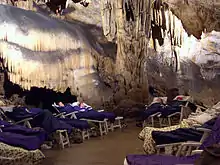Halotherapy
Halotherapy (also known as speleotherapy) is a form of alternative medicine which makes use of salt. Halotherapy is an unproven treatment that lacks scientific credibility.[1] Spa owners attribute a wide range of health benefits to halotherapy.[2]
| This article is part of a series on |
| Alternative medicine |
|---|
 |


Beyond short-term relief associated with dry environment for those trying to excrete sputum, Norman Edelman of the American Lung Association suspects reported improvement in the health condition of patients might simply be due to the placebo effect.[3][4] A recent review of the research supporting halotherapy determined that, out of 151 studies conducted on this topic, only 1 was a well-designed randomized control trial that met their inclusion criteria for a meta-analysis.[5] Researchers found that the majority of the research on this topic has serious methodological flaws that should be considered. Without vigorous control trials, nothing intelligent can be said to promote the purported beneficial effects of halotherapy, despite claims made in the media to the contrary.
History
Many forms of halotherapy have been used for millennia. The earliest known mention of spa resorts date back to 12th Century Poland, in which people were urged to bathe in mineral waters.[6] Modern history of halotherapy dates back to 1843, when a Polish physician named Feliks Boczkowski promoted the idea of salt treatment after noticing that workers at a salt mines, unlike other miners, did not have respiratory or lung problems.[7]
Forms
There are several forms of halotherapy:[6]
- Saline solution inhalations
- Dry salt aerosol inhalations
- Irrigation and lavage
- Saline and brine baths
- Taking the waters (crenotherapy)
See also
- Balneotherapy, the medical use of bathing
- Speleotherapy
- Thalassotherapy, the medical use of seawater
References
- Shah, R.; Greenberger, P. (2012). "Unproved and controversial methods and theories in allergy-immunology". Allergy and Asthma Proceedings. 33 (Supplement 1): 100–102. doi:10.2500/aap.2012.33.3562. PMID 22794702.
- Novella, Steven (June 13, 2018). "Halotherapy – The Latest Spa Pseudoscience". Science-based Medicine. Archived from the original on June 17, 2018. Retrieved June 17, 2018.
- Pokorski, Mieczyslaw (2019). Advances in Biomedicine. Springer. p. 44. doi:10.1007/978-3-030-25373-8. ISBN 978-3-030-25372-1.
- "Promising or Placebo? Halo Salt Therapy: Resurgence of a Salt Cave Spa Treatment". American Lung Association. June 9, 2016. Archived from the original on June 17, 2018. Retrieved June 17, 2018.
- Rashleigh, Rachel; Smith, Sheree (February 21, 2014). "A review of halotherapy for chronic obstructive pulmonary disease". International Journal of Chronic Obstructive Pulmonary Disease. 9: 239–46. doi:10.2147/COPD.S57511. PMC 3937102. PMID 24591823.
- Kamińska, Katarzyna (2014). Halotherapy. Sulejówek: Salsano Haloterapia Polska. p. Transl. Caryl Swift. ISBN 978-83-937819-1-1.
- Shah, Allie (18 November 2013). "Salt therapy is finding new fans, but doctors remain skeptical". Milwaukee Journal Sentinel. Retrieved 16 February 2020.
External links
| Look up halotherapy in Wiktionary, the free dictionary. |
- Dunning, Brian (2013-08-13). "Skeptoid #376: Salt Therapies". Skeptoid. Retrieved 2017-06-15.